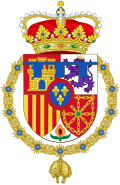| Catherine | |
|---|---|
| Princess of Asturias | |
 | |
| Born | 5 October 1422 Illescas, Toledo |
| Died | 10 September 1424 (age 1 year, 341 days) Madrigal de las Altas Torres |
| Burial | |
| House | Trastámara |
| Father | John II of Castile |
| Mother | Maria of Aragon |
| Religion | Roman Catholicism |
Catherine of Castile (Castilian: Catalina de Castilla; 5 October 1422 - 10 September 1424) was suo jure Princess of Asturias and heiress presumptive to the Castilian throne all her life.
Contents
Catherine was born on 5 October 1422 in Illescas, Toledo. [1] She was the first child of King John II of Castile and his first wife, Maria of Aragon. [2] Named after her grandmother, Catherine of Lancaster, she immediately became heiress presumptive to the throne of Castile upon her birth. [3] The Infanta was formally recognized as successor to the throne of the kingdom and sworn in as Princess of Asturias in early 1523 by the Cortes in Toledo. [4]
Not much is known about Catherine's life. [5] She died of an unknown illness in Madrigal de las Altas Torres on 10 September 1424. [6] Her younger sister, Infanta Eleanor, replaced her as heiress and Princess of Asturias. [7] Infanta Catherine is buried in Miraflores Charterhouse, along with her father and stepmother, Isabella of Portugal.
